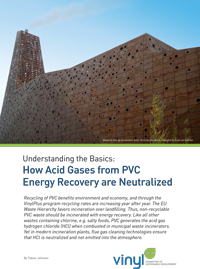How Acid Gases from PVC Energy Recovery are Neutralised
With good reasons, proper waste management stands central in countries that can allocate the necessary resources. In short, humans and environment suffer when waste is disposed of improperly. Backyard burning of household trash emits dioxins, carcinogenic polyaromatic hydrocarbons and particle pollution. Neither is landfilling a good solution, for several reasons.
It takes up space; a scarce resource in densely populated areas. It produces the powerful greenhouse gas methane, which is far more potent than CO2 . Fires are common, causing the same pollution as backyard burning. Also, problematic substances can leach into the groundwater if the landfill is not properly managed.
And not least, trash is a valuable and recoverable resource. These issues are well recognised in the European Union. According to the EU waste hierarchy, the best waste management options are prevention, reuse and recycling, in that order. Next is recovery, or incineration, and lastly landfilling. Of course, the first three options are preferable, but for some types of waste recycling and reusing are neither economically, practically nor hygienically sound.
Further, there are simply limits to how many times a material can be recycled. In these instances, incineration presents itself as the best, though not perfect, solution.

